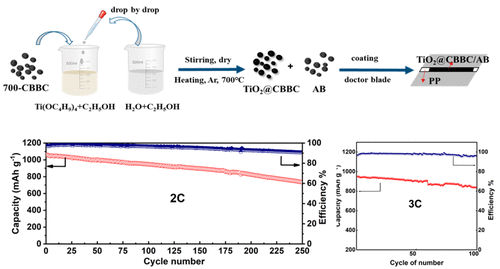当前位置:
X-MOL 学术
›
Ind. Eng. Chem. Res.
›
论文详情
Our official English website, www.x-mol.net, welcomes your feedback! (Note: you will need to create a separate account there.)
TiO2@Chlorella-Based Biomass Carbon Modified Separator for High-Rate Lithium–Sulfur Batteries
Industrial & Engineering Chemistry Research ( IF 4.2 ) Pub Date : 2022-01-19 , DOI: 10.1021/acs.iecr.1c04510 Xin Wang 1 , Liwen Yang 1 , Qian Li 1 , Yang Wang 1 , Yanjun Zhong 1 , Yang Song 1 , Yanxiao Chen 1 , Zhenguo Wu 1 , Benhe Zhong 1 , Xiaodong Guo 1, 2
Industrial & Engineering Chemistry Research ( IF 4.2 ) Pub Date : 2022-01-19 , DOI: 10.1021/acs.iecr.1c04510 Xin Wang 1 , Liwen Yang 1 , Qian Li 1 , Yang Wang 1 , Yanjun Zhong 1 , Yang Song 1 , Yanxiao Chen 1 , Zhenguo Wu 1 , Benhe Zhong 1 , Xiaodong Guo 1, 2
Affiliation

|
The lithium–sulfur battery (Li–S battery) has attracted extensive attention because of its high energy density, but a series of disadvantages caused by sulfur insulation and the shuttle effect hinder the large-scale application of the Li–S battery. The conductive skeleton with strong adsorption on lithium polysulfide can effectively build the electron transmission path and inhibit the shuttle effect. In this study, a new type of chlorella-based biomass carbon skeleton carrying TiO2 metal sites (TiO2@CBBC) is designed and synthesized, and it was used as a functional separator modification material for the lithium sulfur battery. The biomass carbon skeleton has a unique three-dimensional skeleton and a unique specific surface, which can carry uniform titanium active sites and rich oxygen negative ions, so as to build a functional network of electron conduction, adsorbing polysulfide intermediates and promoting the dynamics of the sulfur conversion reaction. The Li–S battery equipped with a functional TiO2@CBBC separator shows excellent rate performance and cycle performance. The initial capacity of the lithium sulfur battery is up to 1011 mAh g–1 at 2C and can maintain 92% of the specific capacity after 100 cycles. At a stricter rate of 3C, the battery can still operate stably, and the coulomb efficiency remains above 95% throughout the entire process. This work represents a promising approach for developing the stability of lithium–sulfur batteries at a high rate.
中文翻译:

用于高倍率锂硫电池的 TiO2@小球藻基生物质碳改性隔膜
锂硫电池(Li-S电池)因其高能量密度而受到广泛关注,但硫绝缘和穿梭效应带来的一系列缺点阻碍了Li-S电池的大规模应用。对多硫化锂具有强吸附性的导电骨架,可以有效构建电子传输路径,抑制穿梭效应。本研究构建了一种新型的小球藻基生物质碳骨架,其载有 TiO 2金属位点(TiO 2@CBBC) 被设计合成,用作锂硫电池的功能性隔膜改性材料。生物质碳骨架具有独特的三维骨架和独特的比表面,可承载均匀的钛活性位点和丰富的氧负离子,从而构建电子传导、吸附多硫化物中间体的功能网络,促进碳的动力学。硫转化反应。配备功能性 TiO 2 @CBBC 隔膜的 Li-S 电池表现出优异的倍率性能和循环性能。锂硫电池初始容量高达1011 mAh g –1在 2C 下,循环 100 次后仍可保持 92% 的比容量。在更严格的3C倍率下,电池仍能稳定运行,全程库仑效率保持在95%以上。这项工作代表了一种有前途的方法,可以高速发展锂硫电池的稳定性。
更新日期:2022-02-02
中文翻译:

用于高倍率锂硫电池的 TiO2@小球藻基生物质碳改性隔膜
锂硫电池(Li-S电池)因其高能量密度而受到广泛关注,但硫绝缘和穿梭效应带来的一系列缺点阻碍了Li-S电池的大规模应用。对多硫化锂具有强吸附性的导电骨架,可以有效构建电子传输路径,抑制穿梭效应。本研究构建了一种新型的小球藻基生物质碳骨架,其载有 TiO 2金属位点(TiO 2@CBBC) 被设计合成,用作锂硫电池的功能性隔膜改性材料。生物质碳骨架具有独特的三维骨架和独特的比表面,可承载均匀的钛活性位点和丰富的氧负离子,从而构建电子传导、吸附多硫化物中间体的功能网络,促进碳的动力学。硫转化反应。配备功能性 TiO 2 @CBBC 隔膜的 Li-S 电池表现出优异的倍率性能和循环性能。锂硫电池初始容量高达1011 mAh g –1在 2C 下,循环 100 次后仍可保持 92% 的比容量。在更严格的3C倍率下,电池仍能稳定运行,全程库仑效率保持在95%以上。这项工作代表了一种有前途的方法,可以高速发展锂硫电池的稳定性。

























 京公网安备 11010802027423号
京公网安备 11010802027423号